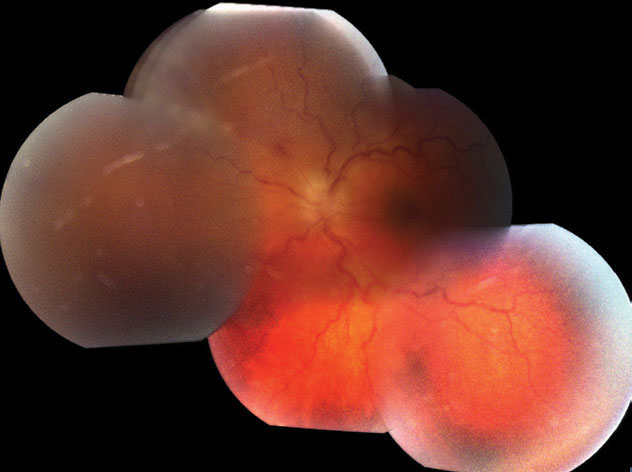 |
|
Research shows that timely antiviral therapy is crucial in managing acute retinal necrosis, with early intervention reducing the risk of retinal detachment and vision loss. Photo: Rami Aboumourad, OD, and Richard Mangan, OD. Click image to enlarge. |
Recently published research showed that retinal detachment (RD) is a frequent and serious complication of acute retinal necrosis (ARN), influenced by several risk factors such as the extent of initial retinitis involvement and the initial intraocular viral load.
“Active local antiviral therapy may reduce the risk of late-onset RD. The antiviral medication should be adjusted according to the inflammatory state,” the study authors noted. “Therefore, timely detection of causative viruses and intensive systemic and local antiviral therapy is crucial for preserving visual function in acute retinal necrosis patients.”
This retrospective, observational analysis, which examined the risk and prognostic factors that impact the long-term clinical outcomes of ARN, included patients with the condition who underwent treatment and completed follow-up from 2011 to 2021.
Researchers enrolled 59 ARN patients (65 eyes) with an average follow-up of 48.9 months. During the follow-up period, retinal detachment was reported in 34 eyes (52.3%). The risk factors for RD included the quadrants of involved retinal necrosis and the initial intraocular viral load. The analysis revealed an independent association between early intravitreal antiviral treatment and a reduced risk of late-onset retinal detachment.
Factors independently linked to an increased risk of final vision loss included poor initial visual acuity and late-onset RD, according to the investigators, who also measured the viral load reduction ratio following the first intravitreal antiviral injection (IAI) and found it strongly correlated with initial intraocular IL-8 concentration and moderately correlated with the initial degree of aqueous flare.
Discussing their research in BMC Ophthalmology, the study authors reiterated that these findings indicated that the initial viral load and the early extent of retinitis were linked to an increased risk of retinal detachment. These factors, they noted, may reflect the severity and progression of the infection, which can lead to retinal necrosis and detachment.
“Our study also showed that late-onset RD may increase the risk of final vision loss related to other factors, such as low initial vision,” the research team wrote. “Therefore, timely detection of viral type and aggressive systemic and local antiviral therapy are crucial for preserving visual function. The shorter interval of IAI application was associated with a reduced risk of late-onset retinal detachment, which suggests that IAI can effectively suppress viral replication and inflammation in the vitreous cavity and prevent further damage to the retina.
“Therefore, eyes with low initial vision and more extensive retinitis or initial viral load at high risk of RD may require closer monitoring for final vision loss,” the study authors concluded. “In addition, early combined systemic and local antiviral therapy in these high-risk patients may reduce the risk of late-onset retinal detachment and final vision loss.”
| Click here for journal source. |
Li Y, Chen L, Li P, et al. Risk factors and prognostic factors associated with retinal detachment and visual outcomes in acute retinal necrosis. BMC Ophthalmol. September 15, 2024 [Epub ahead of print]. |


